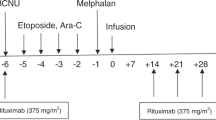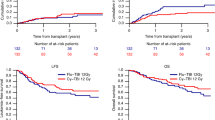Abstract
This analysis compares the regimen-related toxicity (RRT) and overall non-relapse mortality (NRM) in Hodgkin’s disease patients conditioned with either CBV (cyclophosphamide, BCNU (carmustine), and VP16–213 (etoposide)) (26 patients) or CBVP (CBV + cisplatin) (68 patients) followed by autologous stem cell transplantation (ASCT). CBVP included a continuous infusion rather than intermittent doses of etoposide, a lower BCNU dose and the addition of cisplatin. RRT and NRM were determined for each regimen and compared; risk factors for each were examined by multivariate analysis. Grade IV (fatal) RRT occurred in five patients (pulmonary in two, cardiac in two, and central nervous system in one). Eighteen patients experienced grade II–III pulmonary RRT, consistent with BCNU damage in 15. Prior nitrosourea exposure was the main risk factor for pulmonary RRT. Grade II mucosal and hepatic RRT occurred less often after CBVP vs CBV (P = 0.031 and 0.0003, respectively). In addition, three other early and eight late non-relapse deaths were seen. Median follow-up of the entire group is 5.1 (range 2.8–10.2) years. The probability of overall NRM was 26% (95% confidence interval (CI) 13–50%) with CBV vs23% (95% CI 12–41%) with CBVP (P = 0.40). The progression-free survival and relapse rates were similar. Although the rates of fatal RRT, pulmonary RRT and overall NRM were similar with CBV or CBVP, CBVP produced less mucosal and liver RRT with a comparable antitumor effect. As many autografted patients are cured, future efforts should include measures to decrease NRM.
This is a preview of subscription content, access via your institution
Access options
Subscribe to this journal
Receive 12 print issues and online access
$259.00 per year
only $21.58 per issue
Buy this article
- Purchase on Springer Link
- Instant access to full article PDF
Prices may be subject to local taxes which are calculated during checkout
Similar content being viewed by others
Author information
Authors and Affiliations
Rights and permissions
About this article
Cite this article
Reece, D., Nevill, T., Sayegh, A. et al. Regimen-related toxicity and non-relapse mortality with high-dose cyclophosphamide, carmustine (BCNU) and etoposide (VP16-213) (CBV) and CBV plus cisplatin (CBVP) followed by autologous stem cell transplantation in patients with Hodgkin’s disease. Bone Marrow Transplant 23, 1131–1138 (1999). https://doi.org/10.1038/sj.bmt.1701790
Received:
Accepted:
Published:
Issue Date:
DOI: https://doi.org/10.1038/sj.bmt.1701790
Keywords
This article is cited by
-
High-dose BCNU/Melphalan conditioning regimen before autologous stem cell transplantation in newly diagnosed multiple myeloma
Bone Marrow Transplantation (2018)
-
A Review of Autologous Stem Cell Transplantation in Lymphoma
Current Hematologic Malignancy Reports (2017)
-
Single-agent high-dose melphalan followed by auto-SCT for relapsed and refractory Hodgkin lymphoma in children and adolescents
Bone Marrow Transplantation (2012)
-
LACE-conditioned autologous stem cell transplantation for relapsed or refractory Hodgkin's lymphoma: treatment outcome and risk factor analysis in 67 patients from a single centre
Bone Marrow Transplantation (2007)
-
High-dose CEB vs BEAM with autologous stem cell transplant in lymphoma
Bone Marrow Transplantation (2004)



